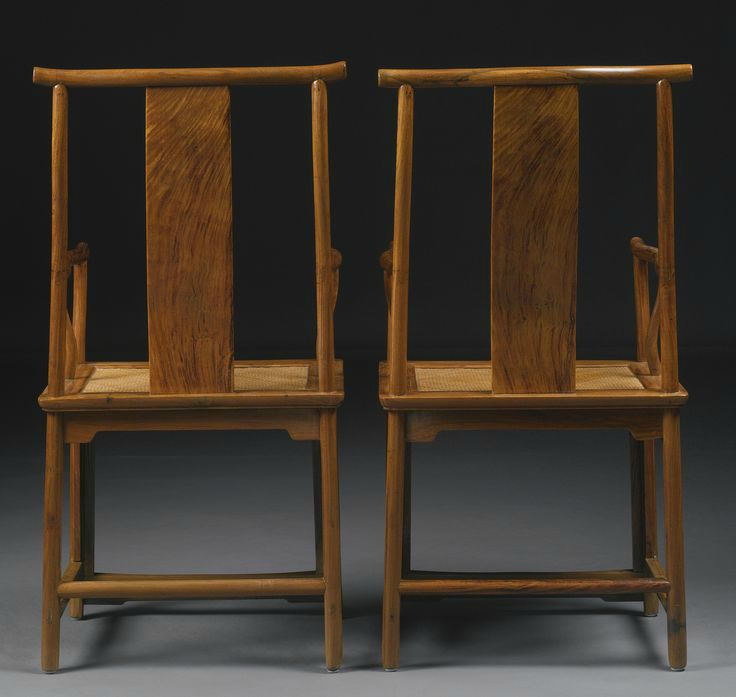A pair of Huanghuali 'Official's Hat' yokeback armchairs (sichutou guanmaoyi), 17th-18th century
Lot 204. A pair of Huanghuali 'Official's Hat' yokeback armchairs (sichutou guanmaoyi), 17th-18th century. Height 42 in., 106.7 cm; Width 19 1/2 in., 49.5 cm; Depth 16 3/8 in., 41.6 cm. Estimate 60,000 — 80,000 USD. Lot sold 100,000 USD. Photo Sotheby's 2015
each with a gently scrolling crestrail terminating in truncated ends, joined to cylindrical posts and a wide S-curved rectangular splat of matching grain, the serpentine outline arms slightly recessed with the truncated ends continuing and supported by shaped brackets, the molded-edge soft-matted seat frame above a straight-edged strutted apron, all resting on cylindrical legs joined by four typically ascending stretchers, the underside with two bowed transverse stretchers (2).
Provenance: Drouot Richelieu, Paris, M. Claude Boisgirard, 24th February 1992, lot 123.
Notes: The present pair of yokeback armchairs, predominantly plain with circular members of consistent thickness and truncated outscrolled ends, focuses the eye not only on the dramatic figuring of the matching grain but on the balance of the form; the curvilinear and rectilinear elements in juxtaposition with the ample use of negative space. This form is generally more comfortable and more extravagant in its use of wood than the straight or C-curved examples. This type of large yokeback armchair is one of the core elements of the classic Chinese furniture vernacular and many examples are preserved in major museums and private collections.
Craig Clunas in Chinese Furniture, London, 1988, p. 20, describes armchairs of this type as being made in pairs, suggesting Chinese room arrangements aimed for symmetry. He further notes that Ming and Qing period literature illustrations characteristically show them used at dinner tables, in reception halls for guests and at the writing table in the scholar’s studio, and illustrates a woodblock print of the 1616 edition of The Golden Lotus (Jing Ping Mei), p. 22, fig. 8. This scene shows the main male figure and his principal wife seated on guanmaoyi while dining, with his secondary wives and concubines seated on stools. For a general discussion on the basic model and decorative vocabulary of these armchairs see Curtis Evarts, ‘From Ornate to Unadorned’, Journal of the Chinese Classical Furniture Society, Spring 1993, pp. 24-33.
A related chair, with an apron comprised of vertical braces but of arched rather than straight form is illustrated in Wang Shixiang, Classic Chinese Furniture, Hong Kong, 1986, pl. 39; and another, from the collection of Gustav Ecke is included in George N. Kates, Chinese Household Furniture, New York, 1948, pl. 86.
Sotheby's. Important Chinese Works of Art, New York, 17 march 2015

/https%3A%2F%2Fprofilepics.canalblog.com%2Fprofilepics%2F1%2F0%2F100183.jpg)
/https%3A%2F%2Fstorage.canalblog.com%2F03%2F02%2F119589%2F96711876_o.jpg)
/https%3A%2F%2Fstorage.canalblog.com%2F11%2F31%2F119589%2F94773502_o.jpg)
/https%3A%2F%2Fstorage.canalblog.com%2F20%2F83%2F119589%2F94772815_o.jpg)
/https%3A%2F%2Fstorage.canalblog.com%2F26%2F72%2F119589%2F75604929_o.jpg)
/https%3A%2F%2Fstorage.canalblog.com%2F59%2F60%2F119589%2F26458628_o.jpg)





/image%2F1371349%2F20240409%2Fob_fc01a6_2024-nyr-22642-0899-000-a-rare-small-h.jpg)
/image%2F1371349%2F20240409%2Fob_1299ed_2024-nyr-22642-0898-000-a-rare-huanghu.jpg)
/image%2F1371349%2F20240403%2Fob_b08891_telechargement-4.jpg)
/image%2F1371349%2F20240403%2Fob_b24488_telechargement.jpg)